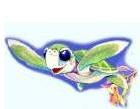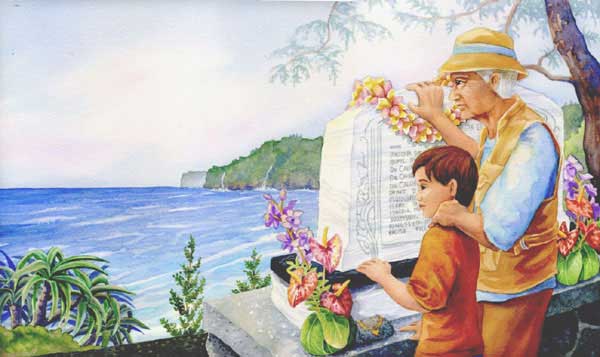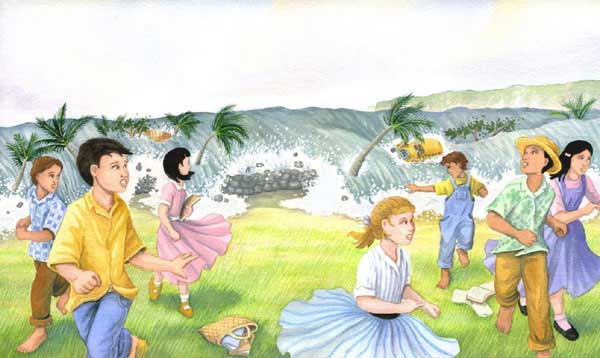
Home


 Home |
 |  |
|---|---|---|
| Children's Book Author & Illustrator | ||
| Just For Kids | Stories that reflect the natural beauty and aloha of Hawaii | |
|
The Keiki Page Activities for kids
Keiki Art Gallery
Turtle Talk |
| Menu |
|
About The Author
Art
Events
Story Time In Hawaii
Writer's Resources |
| Miscellaneous |
 Posters and Gifts From CafePress.com Hawaiian clip art
Privacy Statement,
Web Design 101 |
The Tsunami Quilt: Grandfather's StorySleeping Bear Press, 2007
Young Kimo loves his grandfather very much--they go everywhere together, sharing island stories and experiences. But there is one story his grandfather has yet to share and that is the reason behind their yearly pilgrimage to Laupahoehoe Point. Here, in silent remembrance, Granfather places a flower lei atop a stone monument.
It is only after his grandfather's sudden death that Kimo learns the story behind their annual visit and the reason for the sadness that has haunted his grandfather throughout the years. Evocative writing by award-winning children's book author Anthony D. Fredericks brings this tragic event from Hawaiian history to present-day reality for young readers today.
On September 8, 2007 the Pacific Tsunami Museum in Hilo, Hawaii hosted a free event featuring children's author and illustrator Tammy Yee and her new book, "The Tsunami Quilt." The book is dedicated to the late Bunji Fujimoto, a long time friend and supporter of the museum and a 1946 Laupahoehoe tsunami survivor. Museum director Donna Saiki began the program and Ed Mahoney read the book aloud to the audience. After the reading Donna concluded with some more tsunami survivor stories from Laupahoehoe and the video of the Yoshikazu Murakami story.
The museum has extensive archives of tsunami survivor accounts and photographs and educates the public about the continued threat of tsunamis in Hawaii. You can purchase The Tsunami Quilt directly from the Pacific Tsunami Museum.

I flew to Laupahoehoe in preparation for illustrating The Tsunami Quilt. It was dusk when I arrived--too dark to take good photos, but I wanted to view the site before nightfall to get a feel for the peninsula's geography. The monument, inscribed with the names of the 24 victims who lost their lives in the 1946 tsunami, was covered in offerings. Red Ginger. Ti leaves. Shells. A fragile necklace. I was unaware at the time that in a few days, the small community of Laupahoehoe would observe the 60th anniversary of the tragic event.
In the fading light I noticed a truck parked near the monument. In it was Frank DeCaires, a tsunami survivor who had lost three siblings that day. He told me how the waves withdrew, exposing the ocean floor and stranding fish on the rocky bottom. The waves returned then retreated again, each time higher than before. Children entranced by the sea's peculiar behavior and the gasping fish ran back and forth--away from the incoming waves, then back out onto the emptied bay as the waves withdrew. Some shouted that it was a tsunami, but few took the the warning seriously--after all, it was April Fool's Day. By the time the third wave struck, as high as the palm trees, it was too late.
 I visited the archives at the Pacific Tsunami Museum in Hilo and the Bishop Museum, pouring through photos of Laupahoehoe before and after the tsunami, and of how children of Hawaii dressed in the 40s. I also read through the University of Hawaii's Oral History accounts of the 1946 tsunami--these, along with my chance meeting with Mr. DeCaires, had a profound impact on my illustrations. "It was my intention to put a human face on what had happened that day. Unlike the typical reportage of buildings lost and monetary damage done, this story is about the memories that last long after everything has been rebuilt." in an interview by Keya Keita for The Garden Island Booklist Review, June 1, 2007 Issue~ "Although the events of the tragedy are depicted in the book, the horror is lessened by using a framework story that sets the disaster in the past and by showing children running from the tsunami but not engulfed by it. A historical note is appended. Many readers will respond to this book's soft watercolors, understated tone, and moving story." Through The Looking Glass Children's Book Review~ "Written with great pathos and warmth, the author of this book not only tells the story of a historic event but he also shows his readers how close the grandson and his grandfather are. We are able to see that this is a closeness that the grandson will continue to respect and remember even after his grandfather is gone." Paper Tigers Review~ "The book deals with the difficult themes of loss within families and the devastating sadness of the death of innocent children in natural disasters. Some children may recall the 2004 Indian Ocean Tsunami that took thousands of lives, giving adults an opportunity to talk honestly with them about such disasters." | |||
|
Copyright ©2007 Tammy Yee
|